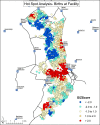"Not too far to walk": the influence of distance on place of delivery in a western Kenya health demographic surveillance system
- PMID: 24884489
- PMCID: PMC4036729
- DOI: 10.1186/1472-6963-14-212
"Not too far to walk": the influence of distance on place of delivery in a western Kenya health demographic surveillance system
Abstract
Background: Maternal health service coverage in Kenya remains low, especially in rural areas where 63% of women deliver at home, mainly because health facilities are too far away and/or they lack transport. The objectives of the present study were to (1) determine the association between the place of delivery and the distance of a household from the nearest health facility and (2) study the demographic characteristics of households with a delivery within a demographic surveillance system (DSS).
Methods: Census sampling was conducted for 13,333 households in the Webuye health and demographic surveillance system area in 2008-2009. Information was collected on deliveries that had occurred during the previous 12 months. Digital coordinates of households and sentinel locations such as health facilities were collected. Data were analyzed using STATA version 11. The Euclidean distance from households to health facilities was calculated using WinGRASS version 6.4. Hotspot analysis was conducted in ArcGIS to detect clustering of delivery facilities. Unadjusted and adjusted odds ratios were estimated using logistic regression models. P-values less than 0.05 were considered significant.
Results: Of the 13,333 households in the study area, 3255 (24%) reported a birth, with 77% of deliveries being at home. The percentage of home deliveries increased from 30% to 80% of women living within 2 km from a health facility. Beyond 2 km, distance had no effect on place of delivery (OR 1.29, CI 1.06-1.57, p = 0.011). Heads of households where women delivered at home were less likely to be employed (OR 0.598, CI 0.43-0.82, p = 0.002), and were less likely to have secondary education (OR 0.50, CI 0.41-0.61, p < 0.0001). Hotspot analysis showed households having facility deliveries were clustered around facilities offering comprehensive emergency obstetric care services.
Conclusion: Households where the nearest facility was offering emergency obstetric care were more likely to have a facility delivery, but only if the facility was within 2 km of the home. Beyond the 2-km threshold, households were equally as likely to have home and facility deliveries. There is need for further research on other factors that affect the choice of place of delivery, and their relationships with maternal mortality.
Figures
Similar articles
-
Factors influencing place of delivery for women in Kenya: an analysis of the Kenya demographic and health survey, 2008/2009.BMC Pregnancy Childbirth. 2013 Feb 17;13:40. doi: 10.1186/1471-2393-13-40. BMC Pregnancy Childbirth. 2013. PMID: 23414104 Free PMC article.
-
The influence of distance and level of care on delivery place in rural Zambia: a study of linked national data in a geographic information system.PLoS Med. 2011 Jan 25;8(1):e1000394. doi: 10.1371/journal.pmed.1000394. PLoS Med. 2011. PMID: 21283606 Free PMC article.
-
Household characteristics affecting where mothers deliver in rural Kenya.Health Econ. 1996 Jul-Aug;5(4):333-40. doi: 10.1002/(SICI)1099-1050(199607)5:4<333::AID-HEC202>3.0.CO;2-K. Health Econ. 1996. PMID: 8880170
-
Place of delivery and perinatal mortality in Kenya.Semin Perinatol. 2019 Aug;43(5):252-259. doi: 10.1053/j.semperi.2019.03.014. Epub 2019 Mar 16. Semin Perinatol. 2019. PMID: 31104765 Review.
-
Women's perceived barriers to giving birth in health facilities in rural Kenya: A qualitative evidence synthesis.Midwifery. 2018 Dec;67:1-11. doi: 10.1016/j.midw.2018.08.009. Epub 2018 Aug 19. Midwifery. 2018. PMID: 30212654 Review.
Cited by
-
Facility-Based Delivery during the Ebola Virus Disease Epidemic in Rural Liberia: Analysis from a Cross-Sectional, Population-Based Household Survey.PLoS Med. 2016 Aug 2;13(8):e1002096. doi: 10.1371/journal.pmed.1002096. eCollection 2016 Aug. PLoS Med. 2016. PMID: 27482706 Free PMC article.
-
Utilisation of health services and the poor: deconstructing wealth-based differences in facility-based delivery in the Philippines.BMC Public Health. 2016 Jul 6;16:523. doi: 10.1186/s12889-016-3148-0. BMC Public Health. 2016. PMID: 27383189 Free PMC article.
-
Gender norms and women's empowerment as barriers to facility birth: A population-based cross-sectional study in 26 Nigerian states using the World Values Survey.PLoS One. 2022 Aug 18;17(8):e0272708. doi: 10.1371/journal.pone.0272708. eCollection 2022. PLoS One. 2022. PMID: 35980968 Free PMC article.
-
Spatial variations of women's home delivery after antenatal care visits at lay Gayint District, Northwest Ethiopia.BMC Public Health. 2019 Jun 3;19(1):677. doi: 10.1186/s12889-019-7050-4. BMC Public Health. 2019. PMID: 31159775 Free PMC article.
-
Promoting OPD Patient Satisfaction through Different Healthcare Determinants: A Study of Public Sector Hospitals.Int J Environ Res Public Health. 2019 Oct 2;16(19):3719. doi: 10.3390/ijerph16193719. Int J Environ Res Public Health. 2019. PMID: 31581643 Free PMC article.
References
-
- Republic of Kenya. The Kenya National Demographic Health Survey 2008–9 Kenya National Bureau of Statistics (KNBS) and ICF Macro 2010 Calverton. Maryland: KNBS and ICF Macro; 2010.
-
- Mwaniki PK, Kabiru EW, Mbugua GG. Utilization of antenatal and maternity services by mothers seeking child welfare services in Mbeere District, Eastern Province Kenya. East Afr Med J. 2002;14(4):184–187. April. - PubMed
-
- Nuwaha F, Amooti-Kaguna B. Predictors of home deliveries in Rakai District Uganda. Afr J Reprod Health. 1999;14(2):79–86. doi: 10.2307/3583363. - DOI
MeSH terms
LinkOut - more resources
Full Text Sources
Other Literature Sources
Medical
Molecular Biology Databases



